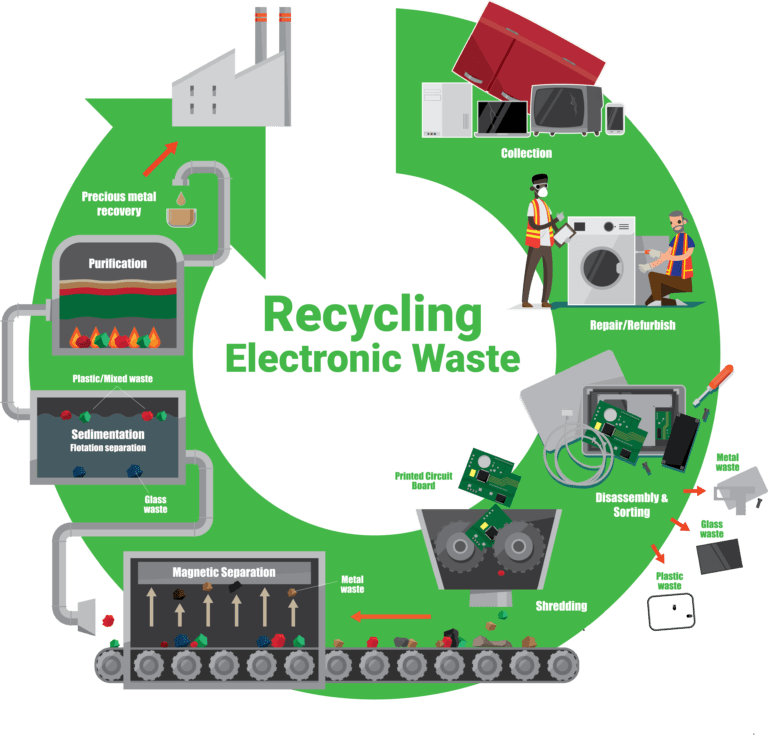
E-Waste + Earth Impact
Every year, millions of tons of electronic waste end up in landfills. By recycling your old devices, you're helping to reduce the amount of toxic materials that seep into the soil and water.
Let's do our part to keep our Earth healthy and safe.
#ewaste #recycling #earthday
-
Soil Pollution
According to a report by the United Nations University, e-waste can contain up to 60 elements on the periodic table, including toxic heavy metals such as lead, cadmium, and mercury. These substances can leach into the soil and contaminate it. The report also estimates that up to 90% of e-waste is disposed of in landfills, which can lead to soil pollution.
-
Water Pollution
A study published in the Environmental Science & Technology journal found that e-waste can release toxic substances into the water supply, including lead, cadmium, and mercury. The study also found that e-waste recycling operations in China were a significant source of these pollutants in local waterways.
-
Air Pollution
According to a report by the Basel Convention, burning e-waste to recover metals can release dioxins, furans, and other toxic substances into the air. The report estimates that the open burning of e-waste is responsible for up to 40% of dioxin emissions worldwide.
-
Resource Depletion
The United Nations University estimates that the value of raw materials in e-waste is worth around $62.5 billion annually. However, only around 17% of this value is recovered through recycling. The remaining 83% is lost due to improper disposal or lack of recycling infrastructure.
-
Energy Consumption
A report by the International Energy Agency estimates that the production and disposal of electronic devices consume around 1,500 TWh of electricity annually, equivalent to the electricity consumption of the entire United Kingdom. This energy consumption contributes to greenhouse gas emissions, which can contribute to climate change.
-
Health Risks
A study by the Environmental Working Group found that recycling workers in the United States who were exposed to e-waste had significantly higher levels of toxic chemicals in their bodies compared to the general population. The study found that these workers had an increased risk of health problems like cancer, neurological damage, and reproductive issues.

Repair vs. Replace
-Environmental Impact-
-
Reducing e-waste
Electronic devices are a significant source of e-waste, which can be harmful to the environment if not disposed of properly. Repairing electronic devices can help reduce the amount of e-waste generated by extending the life of the device and reducing the need for new products.
-
Reducing energy consumption
Electronic devices can consume a significant amount of energy, particularly if they are older or not working efficiently. Repairing these devices can help reduce energy consumption by improving their performance and reducing the need for new, energy-hungry products.
-
Conserving rare and precious metals
Electronic devices contain precious metals and other materials that can be limited or non-renewable. Repairing these devices can help conserve these resources by reducing the need for new products and promoting sustainable resource use.

-
Reducing carbon footprint
The production of electronic devices can result in significant carbon emissions. By repairing electronic devices rather than replacing them, you can help reduce your carbon footprint by reducing the demand for new products and associated emissions.
-
Supporting local economies
Repairing electronic devices can also support local economies by creating jobs and promoting the growth of repair services in your community. This can help reduce transportation-related emissions associated with shipping and manufacturing new products.
-
Promoting innovation
Repairing electronic devices can also promote innovation by encouraging the development of new repair techniques and technologies. This can help create new business opportunities and support sustainable economic growth.
Looking to find an e-waste recycle center locally?
Click and Follow the links below
Get In Touch
- 2450 NW Parkway, Elgin, IL
- info@encorerepair.com
- 1 (800) 436-6448
Links





